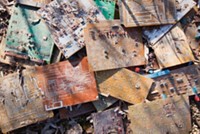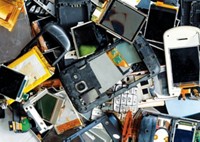Advertisement
Grab your lab coat. Let's get started
Welcome!
Welcome!
Create an account below to get 6 C&EN articles per month, receive newsletters and more - all free.
It seems this is your first time logging in online. Please enter the following information to continue.
As an ACS member you automatically get access to this site. All we need is few more details to create your reading experience.
Not you? Sign in with a different account.
Not you? Sign in with a different account.
ERROR 1
ERROR 1
ERROR 2
ERROR 2
ERROR 2
ERROR 2
ERROR 2
Password and Confirm password must match.
If you have an ACS member number, please enter it here so we can link this account to your membership. (optional)
ERROR 2
ACS values your privacy. By submitting your information, you are gaining access to C&EN and subscribing to our weekly newsletter. We use the information you provide to make your reading experience better, and we will never sell your data to third party members.
Environment
Getting The Lead Out
Electronic Waste: Recovering lead from discarded printed circuit boards could reduce emissions of the toxic metal
by Laura Cassiday
May 26, 2011

Discarded cell phones, computers, and other electronic devices are piling up in landfills, and the toxic materials they release can damage the environment. Now scientists have found a cost-effective way to recover lead from the printed circuit boards that control the devices (Environ. Sci. Technol., DOI: 10.1021/es200243f).
Technological advances quickly make electronic devices obsolete, fueling the worldwide production of 20 to 50 million tons of electronic waste each year, says Zhenming Xu, an environmental scientist at Shanghai Jiao Tong University, in China. People recycle only a small percentage of these products; most of the remainder ends up in landfills or incinerators. When the devices get crushed or burned, toxic heavy metals such as lead, cadmium, and mercury enter the soil, water, and air.
Currently, a lack of efficient methods to recover heavy metals from electronic waste hampers large-scale recycling efforts, Xu says. Xu and his predoctoral student, Lu Zhan, found a way to recover lead from a common component of electronic devices: the printed circuit board. Printed circuit boards are plastic substrates patterned with tiny metal wires that connect electronic components positioned on the board. The wires, which are made of copper and soldered with a mixture of tin and lead, carry electrical current among components.
When the scientists pulverized printed circuit boards and electrostatically separated the metals from nonmetals using a previously published technique, they obtained 0.08- to 1.2-mm copper–rich particles contaminated with small amounts of lead. Xu and Zhan wanted to separate the copper from the lead so that both metals could find reuse as raw materials. So they turned to a technique called vacuum metallurgy separation, which isolates metals based on their differing vapor pressures.
To perform their experiments, the researchers built a vacuum resistance furnace in which they could vary temperature and pressure. Because lead has a high vapor pressure and a low boiling point, Xu and Zhan separated the toxic metal from other metals by melting and evaporating it. Then, they recovered the lead in a separate chamber of the furnace by condensing it from the gaseous phase onto an iron surface. The researchers discovered that by heating copper-rich particles to 1123 K for 90 minutes at a pressure increasing from 0.1 to 1 pascal, they could remove 98.5% of the lead.
The value of the purified copper more than offsets the energy costs to run the furnace, Xu says. More importantly, he adds, widespread use of the vacuum method in recycling facilities would reduce lead contamination in the environment. His group is now applying the method to recover toxic heavy metals from other types of electronic waste, like cathode ray tubes.
Cost-effective methods to recycle electronic waste are especially important in developing nations, which have become dumping grounds for discarded electronic devices, says Derek Fray, a materials scientist at the University of Cambridge. Fray says that Xu and Zhan's technique is more environmentally friendly than existing methods, "although care must be taken to ensure that none of the lead escapes from the furnace because this can be very dangerous."





Join the conversation
Contact the reporter
Submit a Letter to the Editor for publication
Engage with us on Twitter